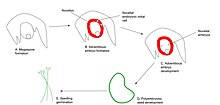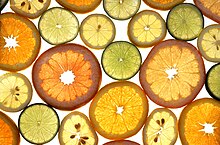User:Epezzuto/sandbox

Wiki is free
I am from Hilo, Hawaii
Evaluate an Article[edit]
I've decided to choose this article because it is relevant to my research topic - angiosperm reproduction. In addition, there is not much information on the topic's wikipedia page. The article's content is relevant to the topic - it explains what nucellar embryony is and why it is important. The page is up to date but is missing a ton of relevant information.
The Lead is concise and introduces the article's topic, but should include more information on the topic.
The article's overall status is that it needs work: more information, more talk on the talk page. From its short paragraph, I see that it is well-developed, but could use more explanation. The article is very clear cut and direct. It has one image but could use more. I can see the image is posted correctly and open for all to view. Article should explain more on the background of double fertilization and where nucellar embryony fits into that process.[2] I think it should also explain how it contrasts with other fertilization processes and what makes it so different. Should also go more in depth about the specific types of flowers affected by this. Overall, the article is underdeveloped.
Nucellar Embryony[edit]
Description[edit]

Nucellar embryony(notated Nu+) is a form of seedreproductionthat occurs in certain plant species, including many citrusvarieties. Nucellar embryony is a type of apomixis, where eventually nucellar embryos from the nucellus tissue of the ovule are formed, independent of meiosis and sexual reproduction.[3]During the development of seeds in plants that possess this genetic trait, the nucellustissue which surrounds the megagametophytecan produce nucellar cells, also termed initial cells. These additional embryos (polyembryony) are genetically identical to the parent plant, rendering them as clones. By contrast, zygoticseedlings are sexually produced and inherit genetic materialfrom both parents. Most angiosperms reproduce sexually through double fertilization. Different than nucellar embryony, double fertilization occurs via the syngamy of sperm and egg cells, producing a triploid endosperm and a diploid zygotic embryo. In nucellar embryony, embryos are formed asexually from the nucellus tissue. Zygotic and nucellar embryos can occur in the same seed (monoembryony), and a zygotic embryo can divide to produce multiple embryos.[4]The nucellar embryonic initial cells form, divide, and expand. Once the zygotic embryo becomes dominant, the initial cells stop dividing and expanding. Following this stage, the zygotic embryo continues to develop and the initial cells continue to develop as well, forming nucellar embryos. The nucellar embryos generally end up outcompeting the zygotic embryo, rending the zygotic embryo dormant. The polyembryonic seed is then formed by the many adventitious embryos within the ovule[5](to picture this process, refer to Figure 1). The nucellar embryos produced via apomixis inherit its mother’s genetics, making them desirable for citrus propagation, research, and breeding.[6]
Nucellar embryony outside of citrus varieties[edit]
Nucellar embryos have also been found in polyembryonic Mango varieties, where generally one of the embryos is zygotic and the rest are nucellar.[7]However, there is little research on Mangos undergoing nucellar embryo development as there has on varieties of citrus.
Conditions[edit]
Nucellar embryony is able to occur within both fertilized and unfertilized ovules. Furthermore, instead of using the endosperm as nutritive tissue, it will utilize the surrounding nucellus tissue for nutrition.[8]For example, the ‘Valencia’ orangeundergoes nucellar embryony in both fertilized and unfertilized conditions.[8]But, it has been found that nucellar embryo development, under fertilized or unfertilized conditions, can take place in different positions.[9]
Features[edit]
An important component of nucellar embryo development is its changing cell wall thickness. Between nucellar embryo’s initial cell stage and its dividing and expanding stage, the cells’ wall thickens.[10]This most likely occurs due to callose deposition; callose deposition reduces the permeability of a cell and is usually found in the initial cells about to undergo embryogenesis.[11]The initial cells become enlarged, rounded, and divided. During this stage, the initial cell’s cell walls thin out, leaving room for the nucleus to become distinguished.
Seedless fruits and influence by the citrus industry[edit]
Many seed plants, including citrus fruits, are self-compatible, meaning that they are able to fertilize themselves. Self-compatibility produces a seedy fruit which may be deemed as undesirable to the citrus industry.
Seedless fruits have been made popular as they are sought-after in the citrus industry. To be seedless, a citrus must exhibit self-incompatibility, another reproductive trait within citrus fruits and many seed plants. Self incompatibility is the phenomena where hermaphroditic plants are not able to produce fertile embryos after self-pollination.[12]Self-incompatibility is regulated by the S-loci; if pollen is rendered incompatible, it is determined by its haploid S genotype, or if its sporophyte is rendered incompatible, it would be determined by its diploid S genotype. This is also termed and associated with parthenocarpy, the production of fruit without fertilization. Self-incompatible fruits are able to undergo parthenocarpy to yield seedless fruits. In citrus specifically, there have been other modes developed to reduce seeding as well: gibberellic acid enhances ovule abortion.[13]and copper sulfate has been shown to reduce seed number in fruit.[14]An example is the ‘Afourer’ mandarin that contains a haploid self-incompatibility system and parthenocarpy. Under conditions where cross-pollination is not present, the ‘Afourer’ mandarin produces a seedless fruit by undergoing parthenocarpy. Where cross-pollination is present, gibberellic acid is applied and produces a decreased seeding fruit.[14]
References[edit]
- ^ Zhang, Siqi; Liang, Mei; Wang, Nan; Xu, Qiang; Deng, Xiuxin; Chai, Lijun (2018-03). "Reproduction in woody perennial Citrus: an update on nucellar embryony and self-incompatibility". Plant Reproduction. 31 (1): 43–57. doi:10.1007/s00497-018-0327-4. ISSN 2194-7953.
{{cite journal}}: Check date values in:|date=(help) - ^ Khan, Iqrar Ahmad (2007). Citrus Genetics, Breeding and Biotechnology. CABI. ISBN 978-0-85199-019-4.
- ^ Zhang, Siqi; Liang, Mei; Wang, Nan; Xu, Qiang; Deng, Xiuxin; Chai, Lijun (2018-03). "Reproduction in woody perennial Citrus: an update on nucellar embryony and self-incompatibility". Plant Reproduction. 31 (1): 43–57. doi:10.1007/s00497-018-0327-4. ISSN 2194-7953.
{{cite journal}}: Check date values in:|date=(help) - ^ Aleza, P.; Juárez, J.; Ollitrault, P.; Navarro, L. (2010). "Polyembryony in non-apomictic citrus genotypes". Annals of Botany. 106 (4): 533–545. doi:10.1093/aob/mcq148. PMC 2944972. PMID 20675656.
- ^ Koltunow, A. M. (1993-10-01). "Apomixis: Embryo Sacs and Embryos Formed without Meiosis or Fertilization in Ovules". The Plant Cell: 1425–1437. doi:10.1105/tpc.5.10.1425. ISSN 1040-4651. PMC 160373. PMID 12271038.
{{cite journal}}: CS1 maint: PMC format (link) - ^ Spillane, C.; Steimer, A.; Grossniklaus, U. (2001-12-01). "Apomixis in agriculture: the quest for clonal seeds". Sexual Plant Reproduction. 14 (4): 179–187. doi:10.1007/s00497-001-0117-1. ISSN 1432-2145.
- ^ Aron, Y.; Gazit, S.; Czosnek, H.; Degani, C. (1998-12-01). "Polyembryony in Mango (Mangifera indica L.) Is Controlled by a Single Dominant Gene". HortScience. 33 (7): 1241–1242. doi:10.21273/HORTSCI.33.7.1241. ISSN 0018-5345.
- ^ a b Koltunow, A. M. (1993-10-01). "Apomixis: Embryo Sacs and Embryos Formed without Meiosis or Fertilization in Ovules". The Plant Cell: 1425–1437. doi:10.1105/tpc.5.10.1425. ISSN 1040-4651. PMC 160373. PMID 12271038.
{{cite journal}}: CS1 maint: PMC format (link) - ^ Wakana, Akira; Uemoto, Shunpei (1987-04). "ADVENTIVE EMBRYOGENESIS IN CITRUS I. THE OCCURRENCE OF ADVENTIVE EMBRYOS WITHOUT POLLINATION OR FERTILIZATION". American Journal of Botany. 74 (4): 517–530. doi:10.1002/j.1537-2197.1987.tb08672.x.
{{cite journal}}: Check date values in:|date=(help) - ^ Wilms, H. J.; Went, J. L. van; Cresti, M.; Ciampolini, F. (1983-01-01). "Adventive Embryogenesis in Citrus". Caryologia. 36 (1): 65–78. doi:10.1080/00087114.1983.10797645. ISSN 0008-7114.
- ^ Wakana, Akira; Uemoto, Shunpei (1988). "Adventive Embryogenesis in Citrus (Rutaceae). II. Postfertilization Development". American Journal of Botany. 75 (7): 1033–1047. doi:10.2307/2443771. ISSN 0002-9122.
- ^ Končalová, Marie Naděžda (1978-12-01). "D. de Nettancourt Incompatibility in angiosperms". Folia Geobotanica et Phytotaxonomica (in German). 13 (4): 370–370. doi:10.1007/BF02851938. ISSN 1874-9348.
- ^ Newbigin, E.; Anderson, M. A.; Clarke, A. E. (1993-10-01). "Gametophytic Self-Incompatibility Systems". The Plant Cell. 5 (10): 1315–1324. doi:10.1105/tpc.5.10.1315. ISSN 1040-4651. PMC 160364. PMID 12271031.
{{cite journal}}: CS1 maint: PMC format (link) - ^ a b Gambetta, Giuliana; Gravina, Alfredo; Fasiolo, Carolina; Fornero, Cecilia; Galiger, Sebastián; Inzaurralde, Cristian; Rey, Florencia (2013-12-17). "Self-incompatibility, parthenocarpy and reduction of seed presence in 'Afourer' mandarin". Scientia Horticulturae. 164: 183–188. doi:10.1016/j.scienta.2013.09.002. ISSN 0304-4238.
